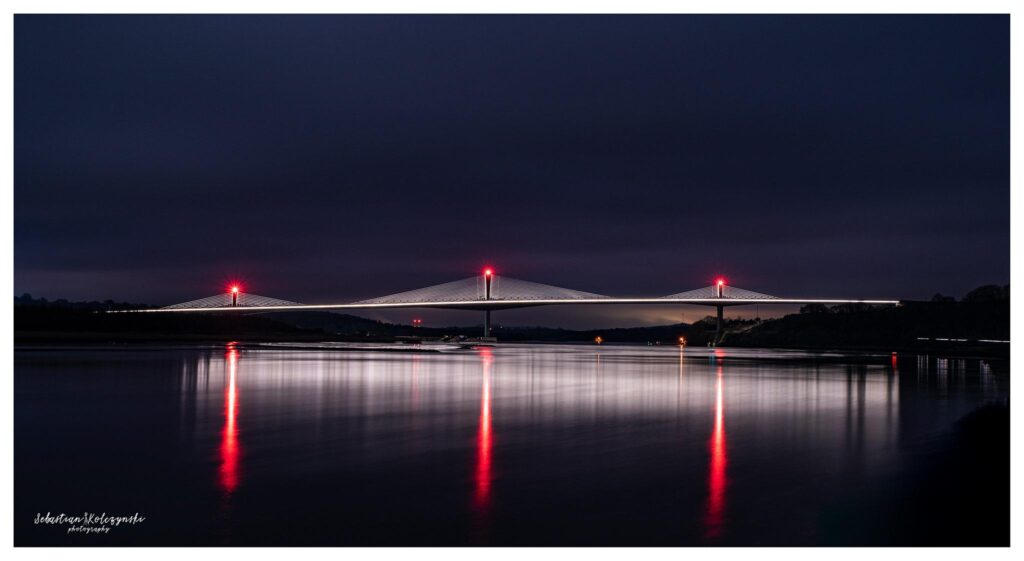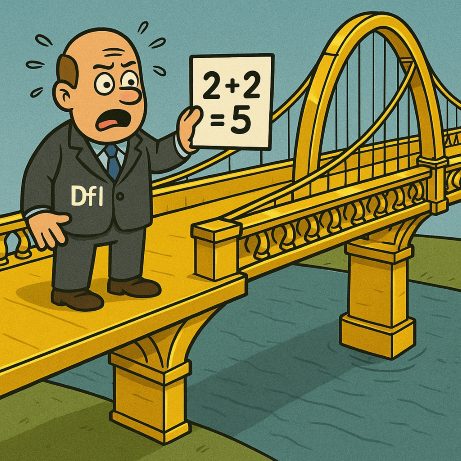

Strangford Lough Crossing: 60 Years of Wrong Sums
- The basic truth
A fixed bridge at Strangford Narrows has been technically possible since the early 1960s.
Government engineers drew it. Civil servants costed it.
Every decade since then, officials have said “it’s not viable”.
But every time they said that, they were using numbers that would not pass a modern test.
There is no sectarian reason the bridge was blocked.
It stalled because of bad economics, risk avoidance, and lack of anyone empowered to deliver it.
- The first serious bridge proposal – 1961 to 1964
Stormont’s Ministry of Commerce (Roads Division) assessed a two-lane road bridge between Strangford and Portaferry.
Key figures from that 1961-62 assessment:
- Estimated build cost: approx £1.8 million (1961 money).
Brought to 2025 prices, that is roughly £112 million. - Traffic assumed: about 300 vehicles per day.
- Ferry operating cost at the time: about £28,000 per year.
- Value placed on a traveller’s time: about 7 pence per crossing.
- Required “rate of return”: 10 percent per year.
Their conclusion was that the bridge “could not be recommended”.
Why that was flawed even then:
- They assumed traffic would stay tiny and ignored induced traffic, tourism and daily commuting growth.
- They treated time savings as almost worthless.
- They treated ferry costs as static and minor, ignoring that ferries get more expensive every decade.
- They applied a 10 percent commercial-style return test to a piece of public infrastructure.
That internal memo became doctrine. It was never properly challenged. It effectively killed the bridge in the 1960s.
- The next 30 years – nothing moves
From the late 1960s into the 1990s, the stock government line became:
“A bridge was examined and found not viable.”
No one re-ran the calculation using updated traffic, higher ferry subsidy, or proper social cost-benefit methods.
The conclusion from the early 1960s was simply repeated.
This was administrative inertia, not community opposition, and not sectarian politics.
Meanwhile ferry support costs rose from tens of thousands per year into six and then seven figures. The public quietly kept paying.
- The 1997 Feasibility Study
In 1997, the Department of the Environment (Roads Service) commissioned a full feasibility study (Scott Wilson Kirkpatrick).
It confirmed that a fixed crossing is technically buildable.
It looked at multiple alignments:
Option A: Direct Narrows crossing (Strangford–Portaferry)
- Approx length: about 1 km including approaches
- 1997 estimated cost: £50–£70 million
- Brought to 2025 prices: about £108–£150 million
- Departmental verdict: “technically feasible but not economically justified”
Option B: Mid-lough route (via islands, approx 3.5 km)
- 1997 cost: £90–£120 million
- 2025 equivalent: about £190–£260 million
- Verdict: “too costly”
Option C: Northern route (Ringhaddy–Killinchy area, approx 5 km)
- 1997 cost: £150–£200 million
- 2025 equivalent: about £320–£430 million
- Verdict: “too costly but lowest environmental risk”
How did they judge “not economically justified” in 1997:
- They again assumed limited traffic.
- They again did not model a toll.
- They did not model wider economic growth on the Ards Peninsula, emergency access benefits, tourism uplift, or reliability savings versus a ferry that can and does stop in bad weather.
- They treated “environmental consent unlikely” as a blocker rather than something to be tested under public-interest grounds.
In other words, the structure of the decision did not change very much from the early 1960s.
- The 2013 statement of “£300 million plus”
Around 2013–2015, internal Department for Infrastructure / DRD briefing material started quoting a headline number of “over £300 million” for “a Strangford bridge”.
That number was produced by inflating old figures and adding risk and contingency.
There was no fresh traffic model published.
There was no fresh ferry subsidy comparison.
But the soundbite “£300 million” achieved one thing politically: it shut the conversation down.
When you convert it forward, that £300 million claim is roughly £390 million in 2025 money.
That is an outlier.
It was never accompanied by drawings, elemental build-ups or procurement basis.
- All historic costs compared in 2025 money
Below are the main cost benchmarks, all normalised to 2025 prices so the public can compare like for like.
1961-62 Stormont bridge appraisal
- Quoted then: about £1.8 million
- 2025 equivalent: about £112 million
- Outcome: rejected on “10 percent return” grounds
1997 Feasibility Study, direct Narrows crossing
- Quoted then: £50–£70 million
- 2025 equivalent: about £108–£150 million
- Outcome: “technically feasible, not justified”
2013 departmental briefing
- Quoted then: “over £300 million”
- 2025 equivalent: about £390 million
- Outcome: used as political proof the bridge is unaffordable
2025 realistic delivery cost using a modern NEC4-style contract for a 1 km two-lane bridge with appropriate clearance
- Ballpark: £120–£140 million
- Note: This is in line with other medium-span UK/Irish estuary crossings delivered in recent decades, scaled for inflation, prelims, contingency and marine works
Key point: Once you strip out political inflation, the cost of “the bridge we actually need” has sat in the £110m–£150m (2025 money) band for more than half a century.
That is astonishing.
- Ferry subsidy versus bridge cost
The ferry now costs on the order of £2 million per year to operate and maintain once you include vessel life-cycle, crews, fuel, insurance, slips and standby provision.
Over a normal 60-year infrastructure appraisal horizon, that recurring support is in the same £120 million range as the bridge itself.
So on long-term public spend, the question is no longer “can we afford a bridge?”
It is “why are we still paying for not having one?”
- Why Strangford stalled when Cleddau Bridge in Wales was built
Cleddau Bridge opened in 1975 across the Milford Haven estuary in Pembrokeshire.
It faced similar engineering issues (tidal channel, estuary span, local economy depending on both sides).
But Cleddau had three advantages Strangford never had: - Local promoter
- Pembrokeshire County Council took ownership of the scheme and created a bridge authority.
- Strangford is nobody’s single baby. It sits between departments and councils.
- Toll finance
- Cleddau was funded through borrowing and repaid with tolls.
- Northern Ireland policy culture resisted road tolls, so Strangford was always forced to look like a 100 percent central government bill.
- Political framing
- Cleddau was sold as essential regional economic infrastructure.
- Strangford was repeatedly framed as “a local ferry issue”.
There is no evidence that religion, community identity or sectarian interest ever blocked the bridge.
It was structural: money, ownership, and risk appetite.
- How the story has been controlled
The public line for 60 years has been: “It’s too expensive and not viable.”
That line rests on three things that should now make people raise an eyebrow:
- The economic test used in the 1960s valued a person’s time at pennies and demanded a 10 percent annual return, as if a rural bridge were a private shopping centre.
- The 1997 study repeated that logic instead of challenging it.
- The 2013 “£300 million plus” claim was allowed to circulate without the working, and then used to shut down debate.
Meanwhile, ferry subsidy has quietly risen to a scale where, over the appraisal life of a bridge, we will spend the same money anyway and still not have permanent access.
- Where this leaves us in 2025
Today’s realistic outturn cost for a direct Narrows bridge is in the range of £120–£140 million.
That is broadly where it always was in real terms.
Traffic is far higher than the 300 vehicles per day assumed in 1961.
The value of time is now calculated in pounds per car-trip, not pennies.
The ferry is already costing what the bridge would have cost.
In other words: the numbers that killed the bridge in the 1960s and again in the 1990s are dead. They just haven’t been buried.
- What needs to happen now
- The Department must release the underlying 1961-62 and 1997 appraisal spreadsheets so that the public can see how “not viable” was calculated.
- A modern cost-benefit analysis must be run using 2025 inputs: current traffic, current ferry subsidy, proper travel-time valuation, emergency response access, tourism uplift, and an allowed appraisal horizon of 60 years.
- A delivery structure must be created. Either a joint Ards and North Down / Newry Mourne & Down style crossing authority with power to raise finance, or a DfI-backed special project with Shared Island and UK co-funding.
- Modest tolling should be on the table if it accelerates delivery. Cleddau did it. We can too.
- The blunt summary line for the public
Stormont said no to a bridge in the 1960s using maths that priced your time at pennies.
That conclusion was never properly updated.
We’ve spent half a century paying ferry subsidy instead of building the link.
By any honest 2025 calculation, the Strangford Lough fixed crossing is not unaffordable. It is overdue. - Sources
- PRONI files COM/62/5/208; CAB/9B/270/3; MOC/62/1/175 (1961-64 bridge appraisal)
- “Feasibility Study – A Fixed Crossing of Strangford Lough”, Department of the Environment Roads Service, 1997
- Department for Regional Development / DfI Strategic Ferry Review papers c.2013
- BCIS and ONS construction cost indices to 2025
- UK Department for Transport travel-time valuation guidance (TAG)
